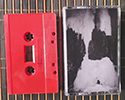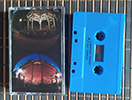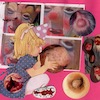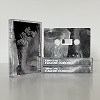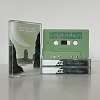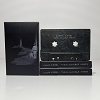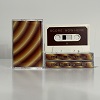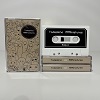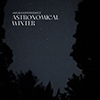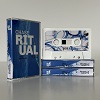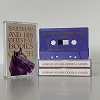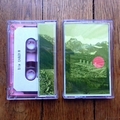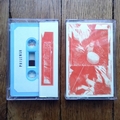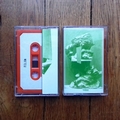Dave Fuglewicz – ‘Selected Works, 1990-1997’
Dave Fuglewicz began experimenting with electronics in the 1970s, and then later only started meddling with recording techniques in 1984. Yet still, he waited another six years before he released his first tape in 1990, which was incidentally the year he claimed to have bought a 4 track recorder. Fuglewicz referred to the period between 1990 and 1997 as his “analog years”, since he began to “go digital” in 1998, and continued to create steadily until his passing in 2021. Since distribution was mainly limited to “the cassette underground”, those of us who care to know can benefit from the intimate knowledge that through limited resources and grainy home dubbed cassettes, and although he was almost self-defeatingly humble in many ways, Dave Fuglewicz created some exceptional, spirited recordings. This collection was compiled with the hopes that the work of Dave Fuglewicz will find a wider audience than it did while he was alive.
SHARKIFACE – ‘Climax In A Process’
It’s hard to believe that this is the first full-length release by Sharkiface, the solo project of Angela Edwards, whose trail of achievements and accolades began in the 90s, in Austin, Texas. Starting with her experience booking and doing tour management for Daniel Johnston, she then moved to the Bay Area and quickly became an important staple, collaborating with local exploding psychedelic stalwarts Hans Grüsel’s Krankenkabinet, Tarantism, and (rumor has it), Caroliner Rainbow, among many others. Sharkiface has toured the United States steadily, with some stints in Europe and Japan, and has been featured at fests such as San Francisco Electronic Music Fest, No Fun Fest, Colour Out of Space, and Ende Tymes, to name a few. For “Climax In A Process”, Sharkiface brings out career-spanning material, but also newer tracks, freshly inspired by her experience achieving an MFA in Electronic Music at Mills College, where she studied under “expert noodle wranglers” such as: Zena Parkins, Laetitia Sonami, John Bischoff, Chris Brown, Tomeka Reid, James Fei and Kala Ramnaf. Although Edwards’ actual process remains somewhat mysterious, it is readily evident that voice is a main impetus for her work, which is, at times, processed through various extremely rare electronic instruments, tape delays, samplers, and other custom devices.
DEATH FACTORY – ‘Vol. 3’
Just in time for Michael Krause’s 35th anniversary as a [home] recording artist, “Vol. 3” is here, collecting material mostly from around ten years ago, with the exception of one track, “…More Disturbing American Policies”, which was for the long since defunct Terry Plumming label in 2001. Being that “Vol. 2” was last released in 2007, we here at NO PART OF IT HQ thought it’d be prudent to continue the series, which initially focused on bringing out-of-print or unheard recordings back into the light once more. For “Vol. 3” two tracks come from releases on the late great NO VISIBLE SCARS label, who put out Death Factory’s “Chilling Impressions” and “Maschinen Unter Kontrolle” to a perfectly primed audience rearing for VHS grit and low grade horror. To round out what would, in a perfect world, be a nice double vinyl LP, “Prophecy” is an unreleased, side-long piece that didn’t make it onto Death Factory’s massive self-released “Prophecy of The Black Spider” 2xC60 tape set (2009), bringing what this author thinks is a montage of the project’s best works (as of this writing) to a close. Although his first live performances didn’t really happen until 2005 or so, Michael Krause has been active since 1988. His first known appearance was on a track with Scott Marshall of the legendary (in some circles) Chicago noise outfit Burden of Friendship, for the 1990 compilation “What Is Truth? (Volume Three)” on Panic Records & Tapes. Over time, Death Factory’s sound has developed into a peculiarly isolationist form of refined, yet still somewhat crude sonic revelry; rife with obscure samples, scrap metal, deathly synth patterns, and monstrous effects, all woven into a unique brand of concrete horrorscape that is as unpretentious as it is inimitable. Not just for fans of industrial noise, people who like genuinely intuitive experimental music, as well as kraut-rock-inspired psychedelic electronic sounds would also find plenty to chew on with this release.
ILLUSION OF SAFETY – ‘ORGAN CHOIR DRONE’
“Organ Choir Drone” features a range of instruments and recorded objects, as per usual for Daniel Burke’s ongoing project, Illusion of Safety, extant as a prominent force in experimental music since 1983. In this particular case, recording artist Arvo Zylo was invited to arrange and sequence a wealth of audio, from finished products to source material to “ready-mades” and everything in between. In some cases, Zylo provided “treatments” of certain events, but mainly it was less a collaboration, and more a pursuit of a “perfect album”, with several revisions, and maybe more minute details belabored than usual. After lots of pontification on the importance of “killing your darlings”, both Burke and Zylo agree that “Organ Choir Drone” is another quality recording deserving of the Illusion of Safety stamp of approval. However, if the listener doesn’t like it, Arvo says that they can blame him.
WILT – ‘CRYPT GLOOM’
WILT has been the main project of James P. Keeler (sometimes solo, sometimes with others) since 1998. Keeler is a graphic designer, visual artist, writer, and multi-instrumentalist, all of it dark always, and as WILT, they rightfully refer to themselves as “Masters of Depression and Decay”. Although they have had their work referred to as “noise ambient” or sometimes simply “dark noise”, which is poignant enough, WILT are especially nuanced. Keeler has collaborated with some heavy-hitters; Cornucopia, Skin Crime, Gruntsplatter, The Rita, and Prurient, to name a few, but it’s hard to compare their brand of industrial-infused, “bleakened” noise, in addition to what often, if we’re honest, inevitably traverses “horror soundtrack” territory, to anything else. After 25 years, WILT continue to not only reinvent the wheel, but show that there is an ongoing intellect and subtlety to their widely cast, yet intricate web of perpetually evolving sound. With “Crypt Gloom”, an unmistakably gothic trajectory continues on into the mist of coffin-smoke synths and foggy swamp organs. “Crypt Gloom” is Part Three in a trilogy inspired by the poetry of Percy Bysshe Shelley, an early 19th Century English poet who risked “political and religious libel” for his atheist/materialist philosophical views in his time. Part One of WILT’s trilogy is “A Deep Reflecting Gloom” and Part Two is “Crypt Hymns”, both released on cassette by Self Abuse Records.
Leslie Keffer – ‘Pollutes’
Although Leslie Keffer started making noise music with radios and voice in 2003, she hadn’t worked outside of her proverbial rural isolationist vacuum, nor had she been truly influenced by noise music until after her first tour. Once she was performing with radios live steadily for a year or two, initially opening for touring acts in Athens, Ohio, a small town where she did booking at a local bar, she found that she didn’t have time to seek through all of the radio static for more nuanced sounds in real time, so she learned to work more in the moment. Accordingly, Pollutes represents Keffer’s first release that is maybe “self-aware” as noise music with a surrounding narrative history. It might be her most harsh work up to that point, but it’s also unique in that it incorporates a vintage Echoplex tape machine for an added analog feel, as well as a toy piano on the final track. Rather than recording onto minidisc as she did before, this series of excursions was recorded direct to tape, initially self-released on home-dubbed cassettes with no digital editing (and no guitar pedals!) of any kind.
BLOOD RHYTHMS – ‘GOOD GRIEF’
Following their Horror Pilation series of 6 LPs, Arvo Zylo and Leslie Keffer did finish one more drone release in 2022, if only as a matter of chance. Keffer was grieving the loss of a loved one, and Zylo sent her a drone, as a “gift”. The audio was made from several different elements, but especially including purported “healing frequencies”, for symbolic value at the very least. This “gift” also based itself off of a one minute long track called “Grief” that Keffer had recently contributed to a compilation. In its original form, the initial 40 minute piece is yet to be released. However, Keffer and Zylo did create three finished pieces from the base materials, almost out of force of habit, since they were in such a zone from creating over six hours of material for the Horror Pilation series. With Good Grief, there has already been a body of work established, and this is an additional look into that process, as well as a finished product in itself.
WEBSITE
